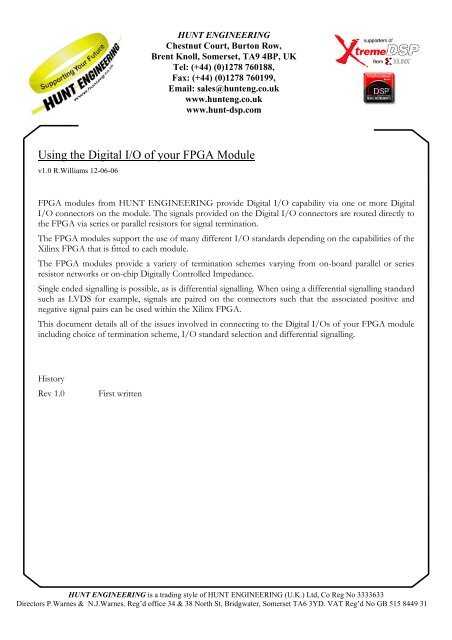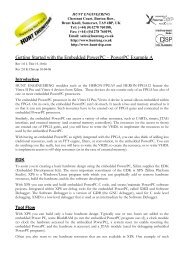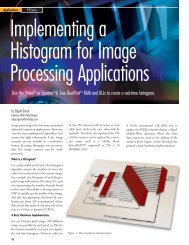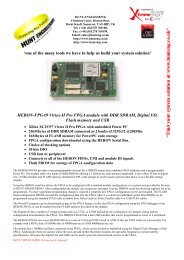FPGA Digital I/Os - Hunt Engineering Ltd.
FPGA Digital I/Os - Hunt Engineering Ltd.
FPGA Digital I/Os - Hunt Engineering Ltd.
You also want an ePaper? Increase the reach of your titles
YUMPU automatically turns print PDFs into web optimized ePapers that Google loves.
HUNT ENGINEERING<br />
Chestnut Court, Burton Row,<br />
Brent Knoll, Somerset, TA9 4BP, UK<br />
Tel: (+44) (0)1278 760188,<br />
Fax: (+44) (0)1278 760199,<br />
Email: sales@hunteng.co.uk<br />
www.hunteng.co.uk<br />
www.hunt-dsp.com<br />
Using the <strong>Digital</strong> I/O of your <strong>FPGA</strong> Module<br />
v1.0 R.Williams 12-06-06<br />
<strong>FPGA</strong> modules from HUNT ENGINEERING provide <strong>Digital</strong> I/O capability via one or more <strong>Digital</strong><br />
I/O connectors on the module. The signals provided on the <strong>Digital</strong> I/O connectors are routed directly to<br />
the <strong>FPGA</strong> via series or parallel resistors for signal termination.<br />
The <strong>FPGA</strong> modules support the use of many different I/O standards depending on the capabilities of the<br />
Xilinx <strong>FPGA</strong> that is fitted to each module.<br />
The <strong>FPGA</strong> modules provide a variety of termination schemes varying from on-board parallel or series<br />
resistor networks or on-chip <strong>Digital</strong>ly Controlled Impedance.<br />
Single ended signalling is possible, as is differential signalling. When using a differential signalling standard<br />
such as LVDS for example, signals are paired on the connectors such that the associated positive and<br />
negative signal pairs can be used within the Xilinx <strong>FPGA</strong>.<br />
This document details all of the issues involved in connecting to the <strong>Digital</strong> I/<strong>Os</strong> of your <strong>FPGA</strong> module<br />
including choice of termination scheme, I/O standard selection and differential signalling.<br />
History<br />
Rev 1.0 First written<br />
HUNT ENGINEERING is a trading style of HUNT ENGINEERING (U.K.) <strong>Ltd</strong>, Co Reg No 3333633<br />
Directors P.Warnes & N.J.Warnes. Reg’d office 34 & 38 North St, Bridgwater, Somerset TA6 3YD. VAT Reg’d No GB 515 8449 31
Connecting to the <strong>Digital</strong> I/O<br />
HUNT ENGINEERING provide example projects for each <strong>FPGA</strong> module. Example projects all use<br />
a common structure based around a Hardware Interface Layer. The Hardware Interface Layer is<br />
connected between the user logic inside the <strong>FPGA</strong> design and the real world signals outside the <strong>FPGA</strong>.<br />
The Hardware Interface Layer is organised as a top level design file that is always named ‘top.vhd’,<br />
and a set of VHDL modules that are responsible for interfacing to key functions such as DDR<br />
memory, Analogue-to-<strong>Digital</strong> devices, <strong>Digital</strong>-to-Analogue devices and HERON FIFO interfaces.<br />
The example projects supplied with the modules instantiate a bi-directional LVTTL buffer for each of<br />
the digital I/<strong>Os</strong>. This is done in the top level design file top.vhd.<br />
The <strong>Digital</strong> I/O connectors are labelled alphabetically starting at A. For each <strong>Digital</strong> I/O connector,<br />
the User-Ap interface to the Hardware Interface Layer will present three buses, each as wide as the<br />
number of bits of <strong>Digital</strong> I/O available on one connector.<br />
The first bus is the input data received by the <strong>FPGA</strong> from the connector, and has a name in the form:<br />
CONN_x_IN, where ‘x’ is the connector label, for example ‘A’ for connector A.<br />
The second bus is the data output by the <strong>FPGA</strong>, and has a name in the form: CONN_x_OUT, where ‘x’<br />
is the connector label.<br />
The third bus is the output enable for the I/O buffer inside the <strong>FPGA</strong>, and has a name in the form:<br />
CONN_x_EN, where ‘x’ is the connector label.<br />
For a board that has three digital I/O connectors, each with 30 digital I/O signals per connector, the<br />
signal entries in the User-Ap entity would appear as follows:<br />
CONN_A_IN : in std_logic_vector(29 downto 0); -- Data input on Conn. A<br />
CONN_A_OUT : out std_logic_vector(29 downto 0); -- Data output on Conn. A<br />
CONN_A_EN : out std_logic_vector(29 downto 0); -- Output enables for Conn. A<br />
CONN_B_IN : in std_logic_vector(29 downto 0); -- Data input on Conn. B<br />
CONN_B_OUT : out std_logic_vector(29 downto 0); -- Data output on Conn. B<br />
CONN_B_EN : out std_logic_vector(29 downto 0); -- Output enables for Conn. B<br />
CONN_C_IN : in std_logic_vector(29 downto 0); -- Data input on Conn. C<br />
CONN_C_OUT : out std_logic_vector(29 downto 0); -- Data output on Conn. C<br />
CONN_C_EN : out std_logic_vector(29 downto 0); -- Output enables for Conn. C<br />
The Output Enable bus is an active low bus. That is, for a <strong>Digital</strong> I/O to be an output from the <strong>FPGA</strong>,<br />
the corresponding output enable would be set to ‘0’ in the user design. The following VHDL example<br />
shows how a logic ‘1’ would be driven out on bit 4 of <strong>Digital</strong> I/O connector B:<br />
CONN_B_OUT(4)
Choosing The I/O Standard<br />
The characteristics of the I/O are governed by the selections made in your <strong>FPGA</strong> design. Some<br />
signalling standards will need a Vref connected to the relevant pins of the <strong>FPGA</strong>, and some output<br />
buffers require a particular voltage to be provided on the Vcco pins of the <strong>FPGA</strong> bank. For a particular<br />
module, it might or might not be possible to provide the Vcco that you want.<br />
By default, the buffers implement the default Select I/O standard for Xilinx <strong>FPGA</strong>s which is Low-<br />
Voltage TTL (LVTTL). The default buffers are also set to have an output current drive of 12mA and<br />
slow slew rate setting.<br />
The I/O standard can be changed by adding component attributes to the buffer instantiations in the<br />
file top.vhd. The following VHDL shows the default buffer instantiation performed in top.vhd:<br />
iDIOA0 : iobuf port map ( T => CONN_A_EN(0),<br />
I => CONN_A_OUT(0),<br />
O => CONN_A_IN(0),<br />
IO => dio_a(0) );<br />
To change the I/O standard to something other than the default low-voltage TTL, the following<br />
VHDL should be added between the architecture and begin lines in the file top.vhd. The exact<br />
syntax will vary depending on the new I/O standard that is required. In this example, the I/O standard<br />
has been changed to Low-Voltage CMOS as follows:<br />
attribute IOSTANDARD : string;<br />
attribute IOSTANDARD of iDIOA0 : label is "LVCMOS25";<br />
To change the slew rate of the output buffers, the following VHDL would be used:<br />
attribute FAST : string;<br />
attribute FAST of iDIOA0 : label is "TRUE";<br />
To change the output drive, the following VHDL would be used:<br />
attribute DRIVE : string;<br />
attribute DRIVE of iDIOA0 : label is "24";<br />
Possible I/O Standards<br />
Some output buffer types require a specific voltage to be connected to the Vcco pins of the <strong>FPGA</strong><br />
bank containing the buffer.<br />
Some modules have fixed Vcco voltages (because of other fixed signals connected to the same <strong>FPGA</strong><br />
bank) and so will not support some of the signalling standards. Typically an input buffer doesn’t require<br />
a Vcco, so these will be supported.<br />
Some modules will offer a jumper, where the Vcco can be easily connected to one of the power<br />
supplies available on the module. Although more difficult it could be possible to connect another<br />
voltage level to the centre pin of the jumper to gain the possibility of other signalling standards.<br />
The Xilinx user guide for each <strong>FPGA</strong> describes what Vcco setting must be used for each Select I/O<br />
standard. When choosing an I/O standard other than the LVTTL default it is important to refer to the<br />
available Vcco options for the module used.<br />
It is also very important to note that most <strong>FPGA</strong> families cannot tolerate 5V signalling directly onto the<br />
pins of the <strong>FPGA</strong>.<br />
3
Some HUNT ENGINEERING <strong>FPGA</strong> modules provide locations for series resistors to be fitted.<br />
These resistors enable 5V signals to be input to the <strong>FPGA</strong>. The series resistors in combination with<br />
input clamp diodes and the over-voltage protection devices limit the <strong>FPGA</strong> input to 3.3V, with the<br />
remaining input voltage being dropped across the series resistor.<br />
The series resistors required for 5V connection must be requested when an <strong>FPGA</strong> module is ordered.<br />
There is no way to provide 5V output signals from the module, but mostly 5V standards will accept the<br />
levels driven from LVTTL which is a 3.3V standard.<br />
Signal Termination<br />
When transmitting and receiving data it is very important to consider signal termination. Depending on<br />
the I/O standard that has been chosen the type and value of the termination will vary.<br />
Properly terminating the <strong>Digital</strong> I/O signals can be done in one of two ways. Firstly, the <strong>FPGA</strong><br />
modules provide locations for resistor packs so that groups of digital I/<strong>Os</strong> can receive series resistors<br />
or parallel termination resistors across a signal pair.<br />
Secondly, with some <strong>FPGA</strong> modules it is possible to use the internal <strong>Digital</strong>ly Controlled Impedance<br />
(DCI) feature of the Xilinx <strong>FPGA</strong>.<br />
Using the Module Resistor Packs<br />
Resistor packs can be fitted to some <strong>FPGA</strong> modules and can perform one of two functions. The first<br />
function is to provide a series resistance between the pin of the <strong>Digital</strong> I/O connector and the <strong>FPGA</strong>.<br />
The second function is to provide a parallel resistor between a pair of <strong>Digital</strong> I/O signals for<br />
terminating a differential connection.<br />
It should be noted at this point that all <strong>FPGA</strong> modules are built as standard with a value of 0 Ohms for<br />
all series termination resistors, and with no parallel resistors fitted.<br />
This means that if a particular termination scheme is required the fitting of resistors, and the values<br />
required must be specified at the time of ordering.<br />
Using <strong>Digital</strong>ly Controlled Impedance (DCI)<br />
Most <strong>FPGA</strong> families allow the use of <strong>Digital</strong>ly Controlled Impedance to control the impedance of<br />
certain I/O pins. For each <strong>FPGA</strong> I/O bank, the <strong>FPGA</strong> uses a pair of external resistors connected to<br />
the VRN and VRP pins of the <strong>FPGA</strong> to define the termination resistance value.<br />
To use DCI the IOSTANDARD attribute must be applied to each I/O instance that requires the use of<br />
digitally controlled impedance. The following VHDL shows an example of how this would be done if a<br />
DCI LVDS buffers were required:<br />
attribute IOSTANDARD : string;<br />
attribute IOSTANDARD of iDIOA0 : label is "LVDCI_33";<br />
To correctly use DCI the right value of external resistance must be connected to the VRN and VRP<br />
pins of the <strong>FPGA</strong>. By default <strong>FPGA</strong> modules are fitted with 50 Ohm resistors to VRN and VRP. This<br />
is the value that is most widely used by the many different DCI I/O standards of Xilinx <strong>FPGA</strong>s. If a<br />
different DCI value is required this must be specified when the module is ordered.<br />
4
Differential Signalling<br />
The Xilinx <strong>FPGA</strong>s support differential signalling formats with I/O pins being grouped together to<br />
form the positive and negative signals of a differential signal pair.<br />
The <strong>Digital</strong> I/O connectors on HUNT ENGINEERING <strong>FPGA</strong> modules are typically pinned out<br />
such that the differential signal pairs of the <strong>FPGA</strong> are on consecutive pins of the connector.<br />
Differential Termination<br />
Differential signalling standards need to be terminated with a resistor between the two halves of the<br />
differential pair.<br />
Early Xilinx families provided this termination by terminating each half of the signal in a split<br />
termination (one to power and the other to ground). While this offers the correct equivalent<br />
termination as far as the AC signal is concerned, it also adds significantly to the static power supply<br />
current. For this reason HUNT ENGINEERING do not recommend using this method.<br />
On boards that have <strong>FPGA</strong>s using this type of termination HUNT ENGINEERING have provided,<br />
external to the <strong>FPGA</strong>, true differential termination resistors. These must be soldered to the board for<br />
signals that will be used as differential inputs, and must not be soldered for differential outputs or single<br />
ended signals.<br />
Later families of <strong>FPGA</strong>s implement a true differential termination that can be selected in your <strong>FPGA</strong><br />
design. In this case HUNT ENGINEERING do not provide the differential termination resistors<br />
external to the <strong>FPGA</strong>.<br />
When using the Camera Link example with <strong>FPGA</strong> families that have true differential termination the<br />
DIFF_TERM attribute must be used in the UCF file using the following syntax:<br />
INST DIFF_TERM = “TRUE”;<br />
Placing Differential Buffers<br />
The example projects supplied with the modules instantiate one bi-directional LVTTL buffer for each<br />
digital I/O signal. When using differential signalling two digital I/<strong>Os</strong> must be connected to the same<br />
differential buffer for each differential connection.<br />
The following VHDL example shows how the first two digital I/O signals on module Connector A<br />
would be converted into a differential input by modifying the top level design file top.vhd:<br />
architecture RTL of TOP is<br />
component IBUFDS<br />
port( I : in std_logic;<br />
IB : in std_logic;<br />
O : out std_logic );<br />
end component;<br />
begin<br />
ibuf0 : IBUFDS port map (I=>dio_a(1), IB=>dio_a(0), O=>Diff_Input);<br />
end RTL;<br />
5
The following VHDL shows how the first two digital I/O signals on module Connector A would be<br />
converted into a differential output:<br />
architecture RTL of TOP is<br />
component OBUFDS<br />
port( I : in std_logic;<br />
O : out std_logic;<br />
OB : out std_logic );<br />
end component;<br />
begin<br />
obuf0 : OBUFDS port map (I=>Diff_Output, O=>dio_a(1), OB=>dio_a(0));<br />
end RTL;<br />
For each differential signal pair there is a positive half and a negative half. For each <strong>FPGA</strong> the Xilinx<br />
documentation indicates whether a signal is the positive part of a pair with a P suffix in the I/O name<br />
or a negative part of a pair with the N suffix. For both signals in the differential pair the I/O number<br />
must match before the P or N suffix.<br />
6












